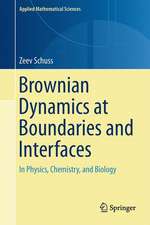The Fractal Dimension of Architecture: Mathematics and the Built Environment, cartea 1
Autor Michael J. Ostwald, Josephine Vaughanen Limba Engleză Hardback – 13 oct 2016
Starting with 625 reconstructed architectural plans and elevations, and including more than 200 specially prepared views of famous buildings, this book presents the results of the largest mathematical study ever undertaken into architectural design and the largest single application of fractal analysis presented in any field. The data derived from this study is used to test three overarching hypotheses about social, stylistic and personal trends in design, along with five celebrated arguments about twentieth-century architecture. Through this process the book offers a unique mathematical insight into the history and theory of design.
| Toate formatele și edițiile | Preț | Express |
|---|---|---|
| Paperback (1) | 694.28 lei 38-44 zile | |
| Springer International Publishing – 16 iun 2018 | 694.28 lei 38-44 zile | |
| Hardback (1) | 696.11 lei 38-44 zile | |
| Springer International Publishing – 13 oct 2016 | 696.11 lei 38-44 zile |
Preț: 696.11 lei
Preț vechi: 915.93 lei
-24% Nou
Puncte Express: 1044
Preț estimativ în valută:
133.20€ • 139.44$ • 110.21£
133.20€ • 139.44$ • 110.21£
Carte tipărită la comandă
Livrare economică 01-07 aprilie
Preluare comenzi: 021 569.72.76
Specificații
ISBN-13: 9783319324241
ISBN-10: 3319324241
Pagini: 304
Ilustrații: XVII, 423 p. 202 illus.
Dimensiuni: 155 x 235 mm
Ediția:1st ed. 2016
Editura: Springer International Publishing
Colecția Birkhäuser
Seria Mathematics and the Built Environment
Locul publicării:Cham, Switzerland
ISBN-10: 3319324241
Pagini: 304
Ilustrații: XVII, 423 p. 202 illus.
Dimensiuni: 155 x 235 mm
Ediția:1st ed. 2016
Editura: Springer International Publishing
Colecția Birkhäuser
Seria Mathematics and the Built Environment
Locul publicării:Cham, Switzerland
Cuprins
1.Introduction.- Part I: Understanding and Measuring Fractal Dimensions.- 2.Fractals in Architectural Design and Critique.- 3.Introducing the Box-Counting Method.- 4.Measuring Architecture.- 5.Refining and Understanding the Method.- Part II: Measuring Twentieth Century Architecture.- 6.Analysing the Form of the Twentieth Century House.- 7.The Rise of Modernity.- 8.Organic Design.- 9.Post-Modernism.- 10.Avant-Garde and Abstraction.- 11.Minimalism and Regionalism.- 12.Conclusion.- References.- Acknowledgments.
Recenzii
“This book is a case-study … displaying its strengths and weaknesses in testing hypotheses regarding the architecture of 85 homes from four continents designed by prominent architects between 1901 and the present day. … Mathematicians will enjoy reading the results of the application of the box-counting method … . the text is both well-written and remarkably error free … . Thank you, authors and editors!” (Joel Haack, MAA Reviews, February, 2018)
“The authors give valuable critical thoughts about a few sensitive problems that researchers face when they use fractal dimension for analyzing images. … 625 architectural plans and elevations (derived from the 85 buildings) are considered and interesting conclusions from the fractal and statistical analysis performed are brought to the reader's attention.” (Elena Hadzieva, Mathematical Reviews, September, 2018)
“It is written by experts who have published a lot on this particular subject on the boundary of architecture and mathematics. … this book is in the first place addressing architect students or researchers … . All the elements of the research methodology, hence also the fractal dimension, are clearly and extensively explained and motivated. Also the analysis of the results and conclusions are carefully described. So it is easy to read and understand for anyone interested in the topic.” (Adhemar Bultheel, European Mathematical Society, euro-math-soc.eu, December, 2016)
“The authors give valuable critical thoughts about a few sensitive problems that researchers face when they use fractal dimension for analyzing images. … 625 architectural plans and elevations (derived from the 85 buildings) are considered and interesting conclusions from the fractal and statistical analysis performed are brought to the reader's attention.” (Elena Hadzieva, Mathematical Reviews, September, 2018)
“It is written by experts who have published a lot on this particular subject on the boundary of architecture and mathematics. … this book is in the first place addressing architect students or researchers … . All the elements of the research methodology, hence also the fractal dimension, are clearly and extensively explained and motivated. Also the analysis of the results and conclusions are carefully described. So it is easy to read and understand for anyone interested in the topic.” (Adhemar Bultheel, European Mathematical Society, euro-math-soc.eu, December, 2016)
Textul de pe ultima copertă
Fractal analysis is a method for measuring, analysing and comparing the formal or geometric properties of complex objects. In this book it is used to investigate eighty-five buildings that have been designed by some of the twentieth-century’s most respected and celebrated architects. Including designs by Le Corbusier, Eileen Gray, Frank Lloyd Wright, Robert Venturi, Frank Gehry, Peter Eisenman, Richard Meier and Kazuyo Sejima amongst others, this book uses mathematics to analyse arguments and theories about some of the world’s most famous designs.
Starting with 625 reconstructed architectural plans and elevations, and including more than 200 specially prepared views of famous buildings, this book presents the results of the largest mathematical study ever undertaken into architectural design and the largest single application of fractal analysis presented in any field. The data derived from this study is used to test three overarching hypotheses about social, stylistic andpersonal trends in design, along with five celebrated arguments about twentieth-century architecture. Through this process the book offers a unique mathematical insight into the history and theory of design.
Starting with 625 reconstructed architectural plans and elevations, and including more than 200 specially prepared views of famous buildings, this book presents the results of the largest mathematical study ever undertaken into architectural design and the largest single application of fractal analysis presented in any field. The data derived from this study is used to test three overarching hypotheses about social, stylistic andpersonal trends in design, along with five celebrated arguments about twentieth-century architecture. Through this process the book offers a unique mathematical insight into the history and theory of design.
Caracteristici
First volume in the new series “Mathematics and the Built Environment” Presents the results of the largest and most mathematically rigorous analysis of architectural form ever undertaken Contains a clear description of the process of using fractal dimensions to measure architecture, along with a detailed demonstration of its application The book is extensively illustrated with new computer-generated images (plans, elevations and perspectives) of 85 famous buildings Includes supplementary material: sn.pub/extras






















